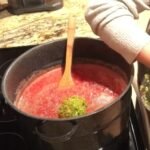How to Can Homemade Salsa: A Step-by-Step Guide

tomatoes
peppers
onions
garlic
cilantro
1
How to Can Homemade Salsa: A Step-by-Step Guide
Hey friends, welcome back to Acre Homestead! My name is Becky, and today we're diving into the art of canning salsa. Though I canned this salsa last summer, I didn't get around to editing the video until now. As part of Sutton’s Days' "Canning in January" collaboration, I’m excited to share this process with you. Now, let’s get started!

2
Ingredients and Preparation
For this salsa, we're using a bounty of homegrown ingredients:
Tomatoes: A mix of varieties including Big Beef and Pineapple.
Peppers: Both sweet and hot, all homegrown.

3
Onions: Walla Walla onions, also from the garden.
Garlic: Fresh and homegrown.
The only ingredient we had to buy was cilantro. Our cilantro wasn't doing great, so we picked some up at the store. Also joining us today is my little French bulldog, Gizmo, who insisted on being part of the action.

4
Recipe Source
Last year, I followed the salsa recipe from the Ball Complete Book of Home Preserving. This year, I’m making a few tweaks, all approved by the National Center for Home Food Preservation. I highly recommend new canners follow recipes exactly for safety. The main change this year is substituting lemon juice for vinegar, which is an approved adjustment.
Step-by-Step Process
Prepare the Tomatoes:
Core and roughly chop the tomatoes. We’re using a food processor to finely dice them.
Note: I don’t peel my tomatoes, but it’s recommended for safety.
Measure and Cook:
Puree the tomatoes and place them in a stainless steel bowl. This helps measure the quantity accurately to ensure the right balance of acidic and non-acidic ingredients.
Heat the canning pot to get a head start on boiling.
Prepare Peppers and Onions:
Dice the peppers and onions finely. We’re using a variety of peppers and sweet Walla Walla onions for a flavorful mix.
Measure out the peppers and onions to maintain the correct ratio for safety.
Cilantro and Garlic:
Roughly chop the cilantro, including some stems for flavor.
Crush the garlic and prepare it for the food processor.

5
Combine Ingredients:
Mix tomatoes, peppers, onions, cilantro, garlic, salt (we’re using pink Himalayan salt), and lemon juice in the pot.
Heat and boil for 10 minutes, stirring regularly to prevent scorching.
Adjust Seasonings
Taste your salsa and adjust the seasonings as needed. We decided against adding cumin to keep the flavors pure and fresh. If you like more heat, you can always add hot sauce later.

6
Canning Process
Fill Jars:
After boiling, fill your jars, leaving a half-inch headspace.
Clean the rims and ensure there are no nicks to guarantee a good seal.

7
Process Jars:
Place jars in the canner with water at the same temperature to avoid breaking.
Once the water is at a rolling boil, process the jars for 15 minutes.
Additional Tips
Straining for Consistency: As the salsa cooks, it might thin out. Strain some of the liquid to maintain a thicker consistency. The strained liquid can be used as a delicious base for soups, rice, or even Bloody Marys.
Clean as You Go: Keeping your workspace clean helps streamline the canning process.
Final Products
We ended up with 14 quarts of thick, delicious salsa and six quarts of seasoned tomato juice. Both are versatile and can be used in various dishes throughout the year.
I hope you enjoyed this canning guide! For more canning videos and tips, check out my other videos linked here. Have a great day, and happy canning!
Becky from Acre Homestead

Ingredients
tomatoes
peppers
onions
garlic
cilantro
Directions
1
How to Can Homemade Salsa: A Step-by-Step Guide
Hey friends, welcome back to Acre Homestead! My name is Becky, and today we're diving into the art of canning salsa. Though I canned this salsa last summer, I didn't get around to editing the video until now. As part of Sutton’s Days' "Canning in January" collaboration, I’m excited to share this process with you. Now, let’s get started!

2
Ingredients and Preparation
For this salsa, we're using a bounty of homegrown ingredients:
Tomatoes: A mix of varieties including Big Beef and Pineapple.
Peppers: Both sweet and hot, all homegrown.

3
Onions: Walla Walla onions, also from the garden.
Garlic: Fresh and homegrown.
The only ingredient we had to buy was cilantro. Our cilantro wasn't doing great, so we picked some up at the store. Also joining us today is my little French bulldog, Gizmo, who insisted on being part of the action.

4
Recipe Source
Last year, I followed the salsa recipe from the Ball Complete Book of Home Preserving. This year, I’m making a few tweaks, all approved by the National Center for Home Food Preservation. I highly recommend new canners follow recipes exactly for safety. The main change this year is substituting lemon juice for vinegar, which is an approved adjustment.
Step-by-Step Process
Prepare the Tomatoes:
Core and roughly chop the tomatoes. We’re using a food processor to finely dice them.
Note: I don’t peel my tomatoes, but it’s recommended for safety.
Measure and Cook:
Puree the tomatoes and place them in a stainless steel bowl. This helps measure the quantity accurately to ensure the right balance of acidic and non-acidic ingredients.
Heat the canning pot to get a head start on boiling.
Prepare Peppers and Onions:
Dice the peppers and onions finely. We’re using a variety of peppers and sweet Walla Walla onions for a flavorful mix.
Measure out the peppers and onions to maintain the correct ratio for safety.
Cilantro and Garlic:
Roughly chop the cilantro, including some stems for flavor.
Crush the garlic and prepare it for the food processor.

5
Combine Ingredients:
Mix tomatoes, peppers, onions, cilantro, garlic, salt (we’re using pink Himalayan salt), and lemon juice in the pot.
Heat and boil for 10 minutes, stirring regularly to prevent scorching.
Adjust Seasonings
Taste your salsa and adjust the seasonings as needed. We decided against adding cumin to keep the flavors pure and fresh. If you like more heat, you can always add hot sauce later.

6
Canning Process
Fill Jars:
After boiling, fill your jars, leaving a half-inch headspace.
Clean the rims and ensure there are no nicks to guarantee a good seal.

7
Process Jars:
Place jars in the canner with water at the same temperature to avoid breaking.
Once the water is at a rolling boil, process the jars for 15 minutes.
Additional Tips
Straining for Consistency: As the salsa cooks, it might thin out. Strain some of the liquid to maintain a thicker consistency. The strained liquid can be used as a delicious base for soups, rice, or even Bloody Marys.
Clean as You Go: Keeping your workspace clean helps streamline the canning process.
Final Products
We ended up with 14 quarts of thick, delicious salsa and six quarts of seasoned tomato juice. Both are versatile and can be used in various dishes throughout the year.
I hope you enjoyed this canning guide! For more canning videos and tips, check out my other videos linked here. Have a great day, and happy canning!
Becky from Acre Homestead

Leave a Review
Please log in or register for a new account in order to leave a review.











